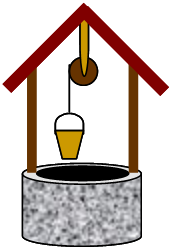A mass falling while attached to a massive pulley. |

A bucket for collecting water from a well is suspended by a rope which is wound around a pulley. The empty bucket has a mass of 2.0 kg, and the pulley is essentially a uniform cylinder of mass 3.0 kg on a frictionless axle. Suppose a person drops the bucket (from rest) into the well.
What is the bucket's acceleration as it falls?
We will consider two different methods to obtain the solution.
Systems:
The pulley and the bucket are treated as separate objects. The bucket can be treated as a point particle, but the pulley must be treated as a rigid body. |
Interactions:
The pulley and the bucket are each subject to external influences from the rope and from gravitys. The pulley is also subject to a force from the axle. |
Model:
Rotation and Translation of a Rigid Body and Point Particle Dynamics |
Approach:
|
Interactions:
The system is subject to external forces from the earth acting on the bucket and the pulley and from the normal force acting on the pulley. |
Model:
Approach:
|
What is the bucket's speed after falling 5.0 m down the well?
Again, we will use two methods.
System:
Bucket as point particle. |
Interactins:
External influences from the earth (gravity) and the rope (tension). |
Model:
Approach:
|
System:
Treat the bucket, pulley and the earth as a single system. |
Interactions:
Internal interactions of gravity (conservative) and tension from the rope (non-conservative) plus an external influence from the normal force on the pulley (non-conservative). |
Model:
Approach:
|